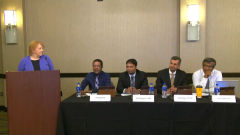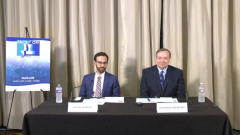
Cross Q&A: Isatuximab + Pom-Dex in Relapsed/Refractory Multiple Myeloma
Panelists from both the Mayo Clinic and UT Southwestern comment on data from ALLIANCE A061202 and consider the role of isatuximab in patients with relapsed/refractory multiple myeloma.
Episodes in this series

Transcript:
Judy Schreiber, PhD, RN: Thank you very much, Dr Kahn. And now questions back from the Mayo team.
Prashant Kapoor, MD, FACP: That was a great presentation, Dr Khan. As you alluded to, this is an all-oral regimen, and that offers a significant advantage. We have some data with this control with studies using the same control arm of PD [pomalidomide plus dexamethasone] with some of those phase 2 trials turning out to be negative studies. Even though we feel that PD is a suboptimal control in the current era, this study at least clearly shows that in phase 2, there is a clear-cut benefit in the PFS [progression-free survival] rates of patients in the triplet arm. But if you were to, let’s say, compare it with the [phase 3 trial] DREAMM-3 [NCT04162210] data that were presented at ASCO [the American Society of Clinical Oncology meeting] utilizing Belamaf [belantamab mafodotin], or the [phase 3] OCEAN-3 study [NCT03151811], which had used melflufen, how do you think this regimen fares compared [with] some of those single-agent studies or melflufen-dex [dexamethasone] study? Where do you think you would be using this regimen?
Adeel Khan, MD, MPH, MS: Those are excellent questions. To some degree here, what is done in our field is often strawman comparisons of quadruplets compared [with] triplets, triplets compared [with] doublets. The actual practice of that in the real world isn’t how we think of patient care. This [phase 1/2] Alliance [for Clinical Trials in Oncology] trial [NCT02004275], it has similarities to the [phase 3] TOURMALINE study [NCT01564537] of ixa-rev-dex [ixazomib-Revlimid (lenalidomide)-dexamethasone], and there was the INSURE study, which was a pooled analysis of also ixa-rev-dex, which confirmed what we suspected, that a triplet is superior to a doublet here. I think what we saw with the belantamab data, is that [PD], in that case, still is an active comparator, and therein lies the risk of comparing oneself to an active comparator, especially as a signal agent where you may not meet endpoints. With the melflufen data, where cytopenias were seen and tolerance was seen as an issue, that also then cost one the potential to say that something is both efficacious and well tolerated. Here, the advantage was what the authors stated at the outright, and the motivation was to come up with an alt oral regimen and to try to move it up in earlier lines of therapy. In that vein, I think it did succeed, and it is worthwhile to consider as something for second line of therapy at first relapse after someone has received lenalidomide and become refractory. The numbers are favorable enough to say that a patient would in fact benefit. So, I would echo that.
Prashant Kapoor, MD, FACP: Yeah. What I found somewhat striking was that in comparison [WITH] the DREAMM-3 study, where the control arm was again, PD, the control arm in this study performed just as well of 7 months PFS. Whereas with DREAMM-3 with single-agent belantamab, there was roughly median PFS of around 11 months, which was almost half of what we saw with this triplet. So, again, a well-tolerated regimen in my clinical experience as well, and certainly an option for patients who are not as fit and may not be able to make it to the clinic to receive other agents such as carfilzomib or elotuzumab or bortezomib, all of which have been tried against doublets in combination with [PD].
Wilson Gonsalves, MD: Again, no question, more of a comment. Again, fantastic presentation. I always struggle in where to place ixazomib; I feel it’s like the stepchild in my treatment algorithm in my head, but at the same time, I think as you mentioned and has been mentioned many times, the option for an all-oral therapy was especially important during the early days of the pandemic and so on. I did end up using it back then. It’s interesting data, and yeah, great presentation. Thank you.
Adeel Khan, MD, MPH, MS: Thank you. That line about ixazomib is spot-on. I always think of it as sort of a forgotten sibling in some ways, and it suffers from the success of its other siblings of bortezomib and carfilzomib, which have been well used, well tried. If we look at the [phase 2] GRIFFIN data [NCT02874742], bortezomib is doubled down as being a solid option. When we have already great proteasome inhibitors, to add yet another one to the mix, it’s certainly a benefit to patients overall, but it is harder to fit in the schema. I certainly echo those exact thoughts. I will also say that the dosing can be a little bit of a challenge to patients because it’s once a week oral with IMiDs [immunomodulatory imide drugs] being given as the 2 weeks on, 1 week off or 3 weeks on, 1 week off. It is easy for a patient to err and miss things by even a day, [which] then has significant consequences. So, savvy patients do best overall; I think that could be said of any situation, but certainly also with ixazomib dosing here.
Abhishek Mangaonkar, MBBS: Yeah. Great presentation again. One question, and I don’t directly care for myeloma patients, but you see them in the hospital admitted with toxicities. So, you see these unique toxicities with carfilzomib with cardiac issues, and is there any advantage of this drug in that regard?
Adeel Khan, MD, MPH, MS: Yes. For ixazomib compared [with] carfilzomib, we do not see the same cardiac issues, the same issues of drops in ejection fraction. Compared [with] bortezomib, we do not see nearly the same rates of neuropathy. So, that is certainly two advantages.
Kebede Begna, MD: Again here, another comment. Most of the time when I have a patient taking oral treatment, I look at the overall social aspect of treatment. For example, if you have a 75-year-old [who] has to drive, he has to bother his grandchildren to bring him to the hospital, insurance approval. Whenever I have a patient, especially when I have patients with acute leukemia, I prefer to give them the oral treatment as much as possible. For those of us who are taking care of patients, we should try to work hard to get oral treatment for many reasons.
Judy Schreiber, PhD, RN: Great comments. Thank you so much.
Transcript edited for clarity.
Newsletter
Stay up to date on recent advances in the multidisciplinary approach to cancer.




















































































